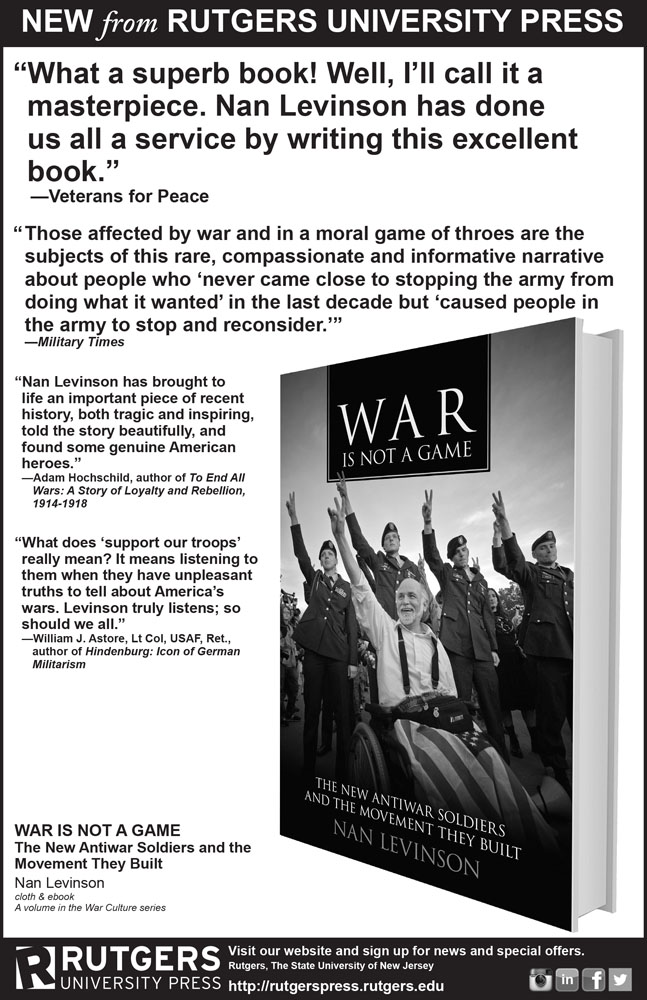 |
War Is Not A GameBy Gerald R. Gioglio (reviewer)
War is Not a Game: The New Antiwar Soldiers and the Movement They Built When it comes to being thoroughly familiar with one's topic, author Nan Levinson is the real deal and her work in "War is Not a Game" makes one want to set that useful baseball cliché in italics. Here we have a comprehensive, engaging account of the birth and development of the Iraq Veterans Against the War (IVAW) along with an in-depth look at key GIs, veterans and civilians who built this and ancillary organizations like Military Families Speak Out (MFSO). This bright and carefully crafted book is essentially journalistic in style, yet can approach participant observation when the author gets more deeply ingrained in events she's reporting. With a reporter's eye and a story teller's bent, the author is nevertheless scrupulous about footnoting source material (documents, email, phone calls) and provides a helpful, focused bibliography and index. "War is Not a Game" features eleven chapters covering events from as early as 2005 with most action taking place from 2007-2009, a time in the development of GI, veteran and military family resistance to the war that Levinson describes as: "...a golden season in the life of a political movement when it is poised between obscurity and banality, inchoate impulse and ossified routine, a time so full of hope, so electric, it practically crackles." Levinson admits that with the emergence of IVAW she became, "strongly drawn" to these anti-war GIs and "realized that these veterans and active-duty soldiers were at the heart of the story I wanted to tell." And tell it she does, with detail, sensitivity and occasional humor keeping the focus on individual players, their thoughts, feelings, motivations, gifts, shortcomings, struggles and commitment to ending the war. Levinson generally sets the stage by reporting on various actions or major events, but throughout we learn about the key actors through conversations, phone interviews and email exchanges that allow the veterans, GIs and activists to speak for themselves. We come to learn how this current generation of anti-war veterans sought to replace what they viewed as a tired protest culture with something uniquely their own; how they wanted to build an organization in their own generation's image. In Chapter 4, Home Fires Burning, we are treated to a nice overview of those who organized and were active in MFSO. In Chapter 5, What Noble Cause, we follow Cindy Sheehan, Gold Star Parents and others who founded and populated Camp Casey. Named for Sheehan's son, killed in Iraq, Camp Casey was located on a plot of land in Crawford, Texas, a few miles from the Western White House. As Sheehan explains it, she planned to stay camped out, "until that jerk (George W. Bush) comes out and tells me why my son died." For Levinson, here at Camp Casey "the most effective protest against the war was born. It would also mark the emergence of IVAW on the national scene." A noble cause, indeed. Some of the more unique activities advanced by this generation of anti-war GIs appear in Chapter 8, Art Heart Dream Peace. Here we see Iraq and Afghanistan veterans exploring, "the interrelations of war, politics and art," while trying to heal emotional and psychological wounds via street theater, spoken performances, poetry and art. One of the most creative healing endeavors involved crafting Combat Paper that is, mashing up old uniforms and turning them into sheets of paper. Paper then used to create prose, poetry or polemics. The pen, especially at the fingertips of those trained to pull triggers, being much, much mightier than the sword. Working with author and scholar, David Cortright we see how Iraq vets made creative use of the Whistleblower Protection Act. Here, over two thousand active duty and returned GIs signed an Appeal For Redress that was sent to members of Congress calling the war futile and seeking the withdrawal of all forces from Iraq. We also see how seasoned peace activists from VVAW and Vets for Peace worked with, mentored and wisely took a back seat, while IVAW built their movement. Still, some GI resistance actions of the past resonated with this new generation of peace activists. So, we see fresh interpretations and use of dramatic actions from the Vietnam era such as Operation RAW and Winter Soldier Investigation. Finally, it was good to see the late Dave Cline quoted here, and in ways that those who knew him would remember; to whit, Dave explaining how a vet sharing his experience was doing an "experiential rap." Classic. Here's the "take-away." If you want to learn more about the good work the current generation of peace warriors has been doing, you want to read or own this book. If you are like me, you'll come away from it inspired and reminded of what it felt like to be in their shoes at their age. Like me, you just might agree that the kids are all right and that the struggle for peace and justice continues to be in good hands. So, let me suggest that those of you who are lifers in the peace movement go TDY. March down to your local library and insist they order a copy of Levinson's fine work. Kids thinking about joining the military, families being harassed by recruiters and those who want to be assured that wars can be resisted will be glad you did. Gerald R. Gioglio, OFS, is a VVAW member and author of "Days of Decision: an Oral History of Conscientious Objectors in the Military during the Vietnam War." Drafted, but opposed to the war, he was discharged from the army in 1969 as a Catholic Conscientious Objector.
|


